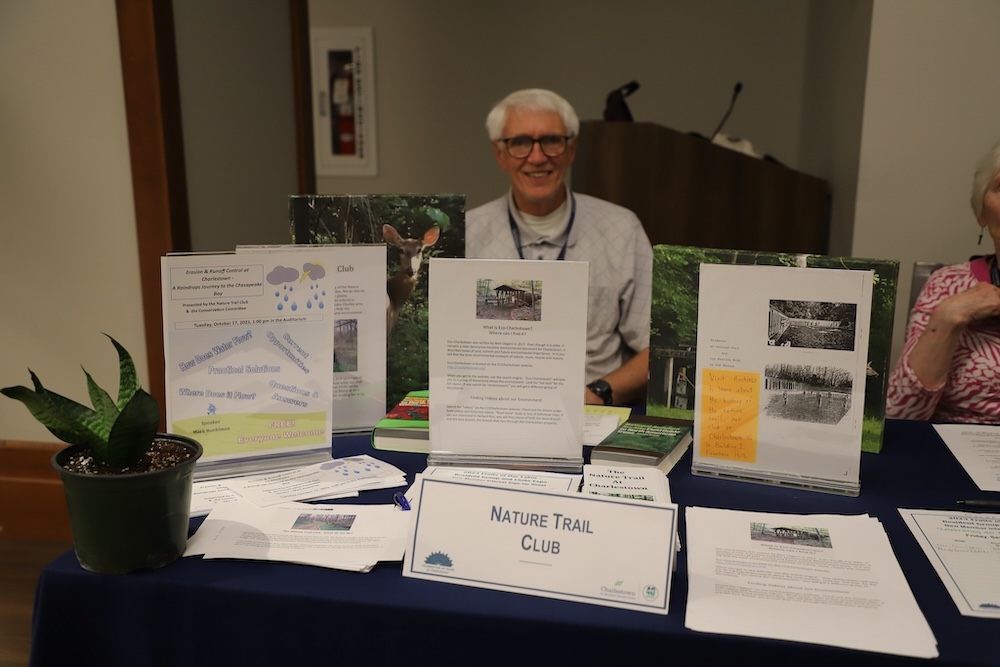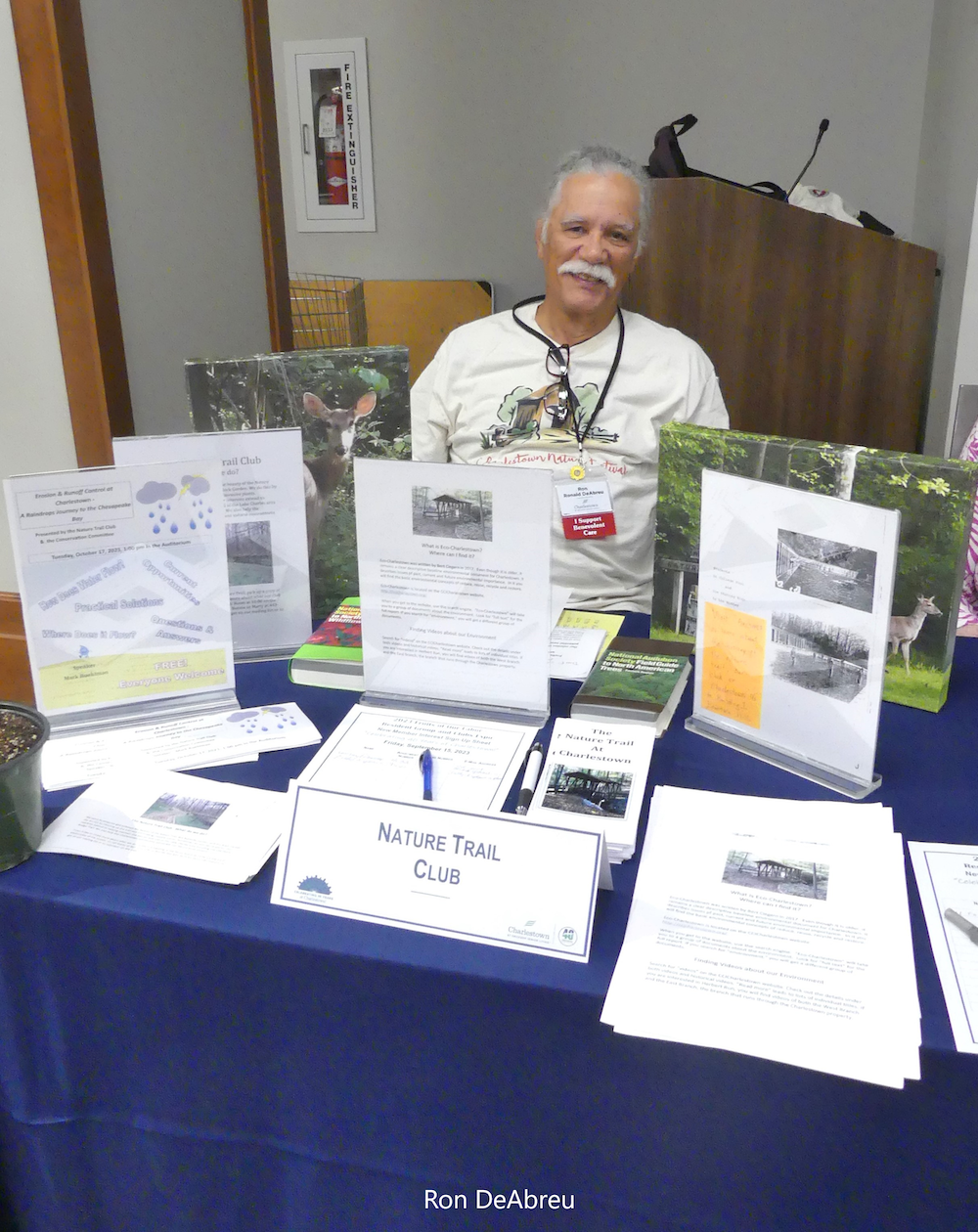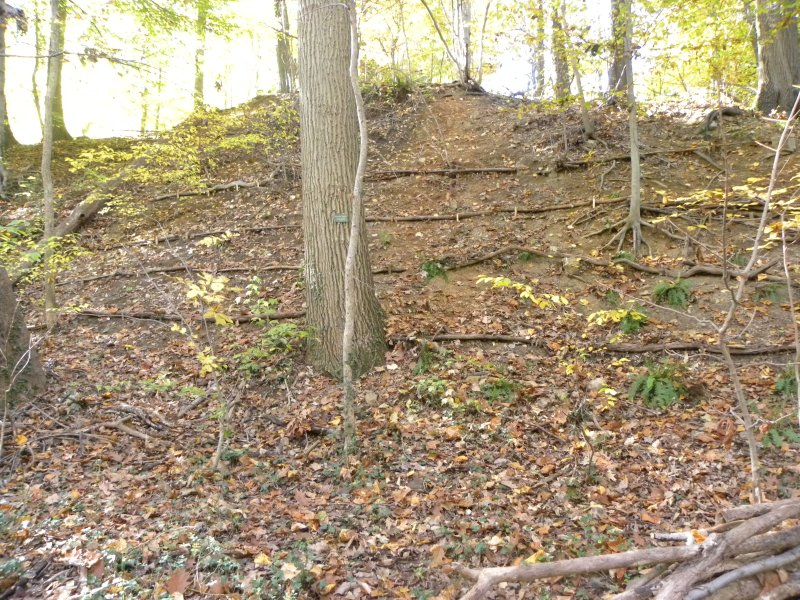Last Updated on October 11, 2023
Nature Trail Club
Bonnie Kawecki, Leader
Donna Ferrara, Co-Leader
The NTC works to preserve and enhance the beauty of the Nature Trail, the Butterfly Garden, the Rock Garden, and the Wildflower Garden by eliminating invasive plants and adding native plants and trees. Our interests extend to helping maintain the beauty and trail of the Lake Charles area including the Old Stone Bridge Trail. We also help the Charlestown community appreciate its natural environment.
Nature Trail Table at the September 2023 Fruits of Our Labor.
| SCHEDULE | TIME | LOCATION |
|---|---|---|
| 3rd Wednesday (Except December) | 10:00 AM – 11:00 AM | Cross Creek Creative Arts Studio |
See information of their activities:
Nature Trail Update
After our usual August hiatus, the Nature Trail Committee got busy again in September. Although it is not a scintillating bit of information, we did finally review and approve our Committee Goals and Actions, They are too numerous for this blog, but they do lay out the extensive interests of the NTC. If you would like an e-copy, please contact me at clegernbl@gmail.com. Equally scintillating, we formed a subcommittee to review and possibly update Wildflower Day, which is a big event for us, and we’d like it to be equally big for all residents.
Progress on various projects we are involved in is as follows:
– Improvements to the Nature Trail are being pursued, including repair of eroded areas and shoring up the edges.
– The Butterfly, Rock, and Wildflower Gardens are soon to be bedded down for the winter.
– The proposed engineering study for improvement of the Lake Trail has been sent out to possible contractors.
– The Grounds Department and Ruppert contractor personnel, working with the Charlestown Tree Working Group, have marked priority dead, dying, and other problem campus trees for removal, mostly along Erickson Way. There are many such trees above and along the Nature Trail, but most are less visible and therefore lower priority. None of these is yet marked for removal.
– New tree and wildflower identification signs for the Nature Trail are being pursued.
– A nascent Birder Group is being developed, as interested staff and resident persons are found.
The next meeting of our Committee will be at 10 AM on Wednesday, October 18 in the Cross Creek Crafts Room.
Bert Clegern
Co-Chairman,
Nature Trail Committee
Nature Trail Committee Update
Our last Nature Trail Committee blog input was in April, just prior to our Wildflower Day celebration on April 20, which went off very nicely. Mother Nature again graced us with her ephemeral presence. Since then a lot has been happening. Our specialty gardens are all looking beautiful in June. The Butterfly Garden has many types of flowers in bloom, with coneflowers currently dominating and a rear echelon of milkweed ready to bloom. The Wildflower Garden is dominated currently by coneflowers and daisy asters (fleabane), with some of the latter rising to 6′ tall. Swamp milkweed and pokeweed form the rear echelon in this garden, along with about a dozen small trees which have been planted here before they are moved to permanent homes. The Rock Garden continues to be a thing of beauty on the Nature Trail, under the Herbert’s Run – St. Charles skywalk. We also have a small new garden being developed around the Nature Trail sign behind Cross Creek where folks can access the middle parts of the Trail.
There were two accidents since April – One a broken ankle due to slipping on a wet wooden stair step on the Trail access from Cross Creek, and the other a tipped-over EMV out on the Lake Trail. Both accidents, and others elsewhere on campus, indicate a definite need for improved new emergency pendants which have GPS capability, and these have been requested by the Residents Council for inclusion in the FY18 Charlestown budget. The slippery wooden steps associated with the Trail have now been covered with skid-resistant colored tape.
Nine tree identification signs have been placed in windows of the high skywalks between Edgewood & Brookside and Herbert’s Run & The St. Charles. The signs are small, but informative, and are placed directly in front of the tree identified. At least a few additional signs are planned for the same walkways.
A new group has been formed on campus – The Tree Working Group (called the TWiG). It is composed of Charlestown, contractor, and Catonsville personnel who have expertise and interest in our campus trees. The purpose of the advisory group is to help develop a more efficient, planned tree program on campus. The first major action was to photographically document and map all trees on the main part of campus which are dead, dying, or otherwise pose a hazard. The trees were individually prioritized for removal, and contractor cost estimates were made on a per tree basis. This information was made available to the Residents Council via the Grounds Committee and inputted to Management for inclusion in the FY18 budget process.
Lastly, a new document is being made available to residents and staff. It is called “Eco-Charlestown“, and it deals with virtually every environmental aspect of Charlestown. It also includes lists of the trees, birds, and mammals of the Charlestown campus.
Bert Clegern
Co-Chairman
Nature Trail Committee
Nature Trail Committee Update
After traditionally skipping August for a meeting, the Nature Trail Committee met September 21 with a full agenda. We will be participating in the annual Fruits of Our Labor event Sep 30 from 11 a.m. to 1:30 p.m. in the Cross Creek Lobby, where many Charlestown clubs and organizations have representatives and displays at tables to provide information on their groups. On October 19 at 1 p.m. in the Auditorium, Harper Griswold will give his interesting presentation on hummingbirds. On October 20, members of the Nature Trail Committee will have their fall Clean-up Day to do routine maintenance on the Trail. Guests are welcome to help. We will meet at the back of the Cross Creek lobby at 10 a.m.
The Butterfly and Wildflower Gardens are in their seasonal downturn, with fewer blossoms being seen, and the seedheads being left for the birds to enjoy. Re our efforts to have gardens conducive to Monarchs, only a few of the butterflies were seen this year, and no caterpillar feeding was seen on our milkweed plants. Perhaps we will have better luck next year.
We have several additional projects which we are supporting or actively working on. These include upgrading the Lake Trail, helping Charlestown in planting more trees on campus, erosion control on a hillside above the Nature Trail and along two areas of Herbert Run, development of identification cards for major tree species beside our skywalks, and improvement of entry areas to the Nature Trail.
If any of these activities sound interesting, come and join us!
Bert Clegern
Co-Chairman
Nature Trail Committee
Nature Trail Update
Both the Garlic Mustard Pull on May 19 and the Stream Clean-up of our portion of East Herbert Run on June 10 were great successes. Each event in its own way helped to environmentally clean up our community. The members of the Nature Trail Committee appreciated the help of the Patapsco Heritage Greenway volunteers, and we showed this by treating them to lunch at the Shortline Cafeteria on both occasions.
Our Butterfly, Rock, and Wildflower Gardens are each coming into their summer beauty. See the Wildflower Garden at the entrance to the Nature Trail on Erickson Way. See the Rock Garden near the covered bridge on the Nature Trail, and see the Wildflower Garden on Erickson Way opposite the Herbert’s Run building.
As part of America’s attempt to reinvigorate the population of Monarch butterflies, Charlestown has multiple “Monarch Waystations” on our campus, where milkweed is being purposefully grown, since this is the only plant on which Monarch caterpillars will feed. We hope that this will contribute in our little way to help replace some of the native milkweed which has been lost to agriculture and herbicides in many parts of the country. The Butterfly Garden and Wildflower Garden are just two of these waystations, where nectar-producing flowers are also made available for the adult butterflies to feed on.
Five American Elms have been planted on campus as part of the Charlestown tree restoration program. The elms are cultivars which have been bred to be resistant to the Dutch Elm Disease, which wiped out virtually all of these beautiful trees in our country back in the 1950s. These elms bring up to 66 the number of different tree species on campus. In a broader perspective, I am now proposing to Management the development of a Tree Working Group to better organize and manage the short and long-term planning and maintenance of both native and introduced trees on campus.
Bert Clegern
Co-Chairman, Nature Trail Committee
Nature Trail May 2016
Nature Trail Updates
Winter is still departing us, but some early crocuses are blooming in gardens, so there is hope for spring. Walking the Nature Trail at this time of year is an adventure, and not yet recommended for several weeks. Testing it out in late February, I found that I could slip on snow, ice, or mud, depending on where I was. In fact, my shoes got sucked off twice in mud, so wear something tight and sturdy if you venture out now.
On April 6 members of the Nature Trail Committee will have a Trail Clean-up Day, during which we will also clean any trash out of the Run and off the adjoining hillsides. This is not only spring cleaning, but is also preparation for our biggest day of the year, Wildflower Day, which this year will be on Friday, April 22, Earth Day. We will have Trail and nature displays, movies, raffles, and homemade cookies in the Cross Creek and Chesapeake lobbies from 11:00 a.m. to 2 p.m. We will also have at least one guided walk on the Nature Trail to discuss its features, especially any spring flowers in bloom.
One additional thought: The other day as I was entering the skywalk from Brookside to Edgewater, I looked down to the left (east) to see the Nature Trail. On the first windows you come to, I noticed ghostly images on the outer glass. There were more than a dozen before recent rains washed many off, but they were impacts from where doves flew into the glass. The reason for this was people feeding the birds from upper Brookside balconies. The birds would wait in nearby trees for the food and then either fly from the trees or balconies, with some hitting the glass of the skywalk. I looked on the ground below the skywalk and did not find any stunned or dead birds, so hopefully none were killed. The folks who were feeding the birds this way were asked by management to cease and desist, so this problem should be over, not to mention ending the rain of bi rd poop on lower balconies and patios. At the end of February you could still see a few birds waiting in the trees, hopeful for a winter handout, but they will learn to look elsewhere. The attached picture (looking up at the eave of the skywalk) is my best effort to show the impact image of one bird, and if you look closely you can see the outline of the body and wings on the glass. Nature is always interesting, and animals will always take advantage of whatever food source they can find, even if they get knocked silly in the process.
rd poop on lower balconies and patios. At the end of February you could still see a few birds waiting in the trees, hopeful for a winter handout, but they will learn to look elsewhere. The attached picture (looking up at the eave of the skywalk) is my best effort to show the impact image of one bird, and if you look closely you can see the outline of the body and wings on the glass. Nature is always interesting, and animals will always take advantage of whatever food source they can find, even if they get knocked silly in the process.
Bert Clegern
Co-Chairman, Nature Trail Committee
Nature Trail Updates
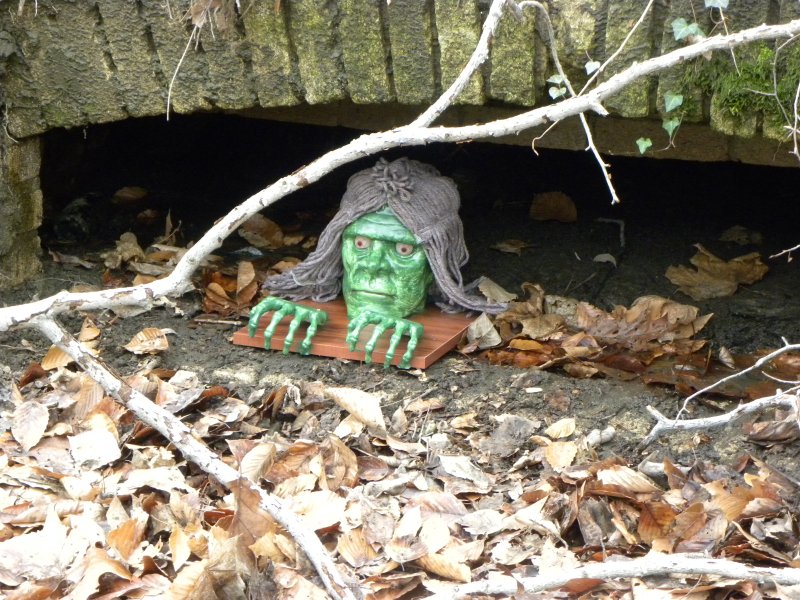 This time of year, the Nature Trail is a fairly dormant operation, but a few things keep it interesting. For one, we have added a troll (see pic). He is properly green and peers out from the old spring opening, which seems appropriate, since by Norwegian lore they live in caves. He is about 50 feet from the covered bridge, which is also appropriate, since they reportedly like to hide under bridges and reach up to grab passersby. To round things out, the series of tree section seats nearby can be considered the trolls’ meeting room. Anyhow, kids especially like this part of the Nature Trail, and now they have another reason to enjoy it.
This time of year, the Nature Trail is a fairly dormant operation, but a few things keep it interesting. For one, we have added a troll (see pic). He is properly green and peers out from the old spring opening, which seems appropriate, since by Norwegian lore they live in caves. He is about 50 feet from the covered bridge, which is also appropriate, since they reportedly like to hide under bridges and reach up to grab passersby. To round things out, the series of tree section seats nearby can be considered the trolls’ meeting room. Anyhow, kids especially like this part of the Nature Trail, and now they have another reason to enjoy it.
The old dead (but spectacular) weeping cherry tree in front of the Chapel was taken down last week, but it will be recycled in the form of its chips being added to the Nature Trail. Please see the separate blog input on the tree.
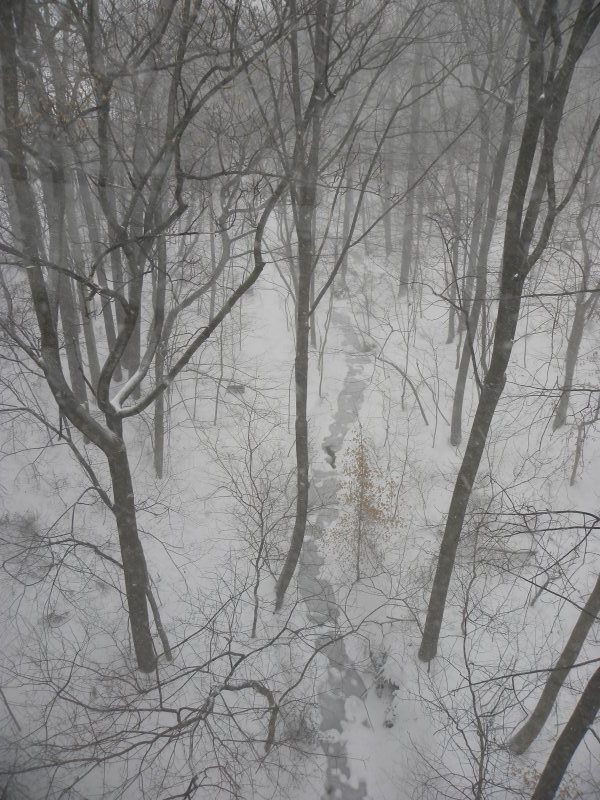 At Lake Charles the Grounds Department has had a contractor treating invasive plants in the Lake until the end of the year. This is done annually, with one chemical being used for algae control, and another chemical being used for control of water primrose. The latter is a rooted invasive plant with a pretty yellow blossom, but it grows to the point that it chokes the margins of the Lake, which is especially perturbing to our fishermen and members of the Black Swan Yacht Club. Also at the Lake, a new section of fence was put in on the east side, because intruders had collapsed part of the old fence. The uninvited guests had not only compromised our perimeter security, but the purpose of their visits was to go fishing, and they didn’t exactly obey our catch-and-release policy at the Lake.
At Lake Charles the Grounds Department has had a contractor treating invasive plants in the Lake until the end of the year. This is done annually, with one chemical being used for algae control, and another chemical being used for control of water primrose. The latter is a rooted invasive plant with a pretty yellow blossom, but it grows to the point that it chokes the margins of the Lake, which is especially perturbing to our fishermen and members of the Black Swan Yacht Club. Also at the Lake, a new section of fence was put in on the east side, because intruders had collapsed part of the old fence. The uninvited guests had not only compromised our perimeter security, but the purpose of their visits was to go fishing, and they didn’t exactly obey our catch-and-release policy at the Lake.
Lastly, as I write this blog on January 23, it is still snowing, with at least 18″ on the ground at mid-day, so I thought a couple of snow pix of the Nature Trail might be appropriate
Bert Clegern
Co-Chairman
Charlestown Nature Trail Committee
Fall Activities on the Nature Trail
If you walk along the Nature Trail, be sure to notice the new erosion control branches staked into the hillside just downstream of the covered bridge. Members of the UMBC Lambda Chi Alpha service fraternity completed this backbreaking work during our recent Fall Trail & Stream Clean-up Day. We were more than happy to let them clamber up the hill, and more will be done in the future. The Clean-up Day also revealed a small old dump area in the bank of the feeder stream near the upper end of Herbert Run on campus. The dump area was long ago covered up by soil, but erosion of the bank was allowing bottles and crockery to fall into the stream. We picked up what we could of the debris, and we will do more to clean the area or at least contain it.
The gardens associated with our Nature Trail Committee have pretty much gone dormant for the season, with two exceptions. The Butterfly Garden still has its white Fall Daisies in bloom, although they are drooping a bit. In the Wildflower Garden, most of the flowers at the front of the Garden are still in colorful bloom, although many of them also are drooping. A few noticeable exceptions are the Giant Marigolds (Tagetes erecta).
These late-blooming plants have grown to 8-9 feet tall, considerably higher than their maximum height of 5 feet. I guess that we won’t have to add fertilizer to this garden for several years.
Out on the Lake Trail, you may notice a large number of invasive black locust saplings growing on the dam. Codes for earthen dams state that the structures should not have trees growing on them, but years ago when the dam was built, little was done to control what vegetation established itself on the soil surface. So we got mostly invasive species, like the black locusts, honeysuckle, and multiple types of weeds growing on the dam.
The locusts grew into full-fledged trees, which eventually were cut down, but the remnants of the trees continue to send up sucker saplings, which grow about five feet per year, so they have to be cut back. Our campus Invasive Plants Crew plans to cut these thorny trees in the early spring. That is when access to them is still easy, and the sap has started flowing so that poison applied to the cut stems will hopefully be carried to the roots and kill the trees.
This time of year be sure to enjoy the fall foliage on campus. The trees are a splendid part of our scenery, even if just viewed from our skywalks above the Nature Trail.
Bert Clegern
Nature Trail Committee Co-Chairman
Nature Trail Clean-Up
The latest Nature Trail Committee news is our Fall Clean-up of the Trail and Stream. On Saturday, October 10, 23 people participated in a 2-hour weekend clean-up. Then on Wednesday, October 14, ten people participated in our weekday 2-hour clean-up.
We got a lot accomplished:
- The Trail was cleaned,
- ivy cut off trees,
- tree branches were disposed of,
- the stream was cleaned, and
- branches were staked across an eroding hillside to help prevent further erosion.
Three students from UMBC’s Lambda Chi Alpha service fraternity helped us on Saturday.
The Butterfly Garden has been cut back for the winter, except for the late-blooming fall daisies. The Wildflower Garden continues to show its abundant color. The milkweed in the Monarch Garden near Lake Charles has gone dormant, but it will regrow in the spring, supplemented by new plants.
As leaves start to fall off the trees, we will be able to see more and more of the Nature Trail and its parallel stream. The views from our skywalks that cross 50 feet above the floor of our small valley are especially good for viewing. Be sure and notice the changes from season to season.
Bert Clegern
Co-Chairman
Charlestown Nature Trail Committee
Butterfly Garden and Milkweed
The Nature Trail continues to be a serene place to take a walk on the Charlestown campus. During the summer it has been at least 10 degrees cooler than upper, sunnier areas. A couple of trees came down across the western end of the Trail in July, but they were quickly removed by Grounds personnel.
The Butterfly Garden at the front of the Nature Trail had its usual seasonal beauty, with the flowers left to go to seed for the birds which enjoy them. The new Wildflower Garden on Erickson Way across from the Herbert’s Run building has been a successful show of color. It has sported a 10 foot tall specimen of Horseweed which we named “Goliath”, and it was left in place due to its unusual size. (The weed normally grows no higher than 7 feet tall.) The weed was topped when it started going to seed, since it’s considered a noxious invasive species in some states.
Swamp milkweed was planted last year in a narrow Monarch Garden above the Lake, and several varieties also are in the Butterfly Garden and the Wildflower Garden. These plantings were done to encourage Monarch butterfly populations, whose larvae feed only on milkweed. Monarch populations have been dwindling in recent years, and we like to try to do our part to support them. More than 20 Monarch caterpillars were seen this summer in our gardens.
The Nature Trail Committee also hosted a talk entitled How Many Trees Does It Take to Make a Forest? by local forester Jim Himel. Jim has supervised the planting of more than 500 trees in the Catonsville area.
The Nature Trail Committee meets on the third Wednesday of the month (except August and December) at 10:00 a.m. in the Cross Creek Crafts Room on the Charlestown campus. Please join us as a member or guest.


